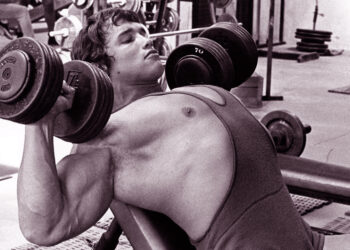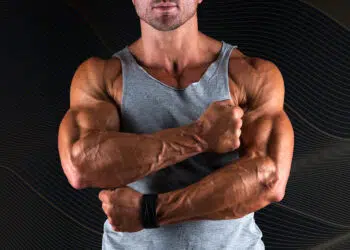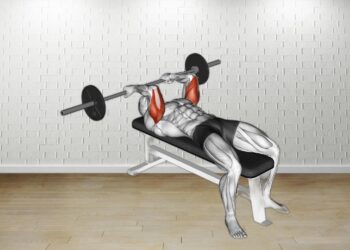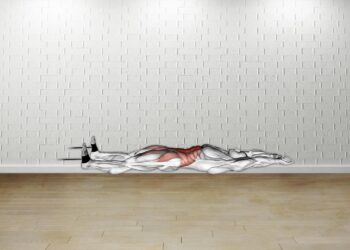The biceps and forearms are the first muscles we see when wearing a t-shirt and if you want them to turn heads, you need to train them hard. Now, let’s get something straight… training hard doesn’t mean overtraining. You see, the biceps and forearms are relatively small in comparison to the larger muscle groups like back, chest, and shoulders; which means they are more susceptible to overtraining.
Moreover, they don’t need to be annihilated but simply stimulated with few sets and reps a few times per week and no more. Biceps and forearms receive heavy stimulation from deadlifts, rows, pull-ups and any movement where pulling is required.
But when you want to isolate your biceps and forearms, dumbbell hammer curls are the perfect exercise to make them massive and strong.
In this Exercise
- Target Muscle Group: Brachioradialis, brachialis, and biceps brachii
- Type: Strength
- Mechanics: Isolation
- Equipment: Dumbbells
- Difficulty: Beginner
Muscles Worked
Brachialis
The brachialis is a pure elbow flexor at all physiological positions, located deep to the biceps. It helps to create the appearance of more width to the upper arm.
Brachioradialis
The brachioradialis is a forearm muscle that flexes the elbow. It also supinates and pronates the forearm.
Biceps brachii
The biceps brachii or biceps is a two-headed muscle of the upper anterior arm that acts as a strong supinator of the forearm. It also flexes the low to a lesser degree and has a small action at the shoulder as the long head crosses the shoulder joint.
Level Up Your Fitness: Join our 💪 strong community in Fitness Volt Newsletter. Get daily inspiration, expert-backed workouts, nutrition tips, the latest in strength sports, and the support you need to reach your goals. Subscribe for free!
Exercise Instructions
- Place your feet about shoulder-width apart and stand straight holding the dumbbells by your sides.
- Curl both dumbbells up and squeeze for a second, keeping your upper arms against your sides.
- Lower the dumbbells slowly and repeat for the desired number of reps.
Tips
- You can curl both dumbbells simultaneously or by alternating.
- The elbows can move slightly forward during the curl but keep the upper arms as close to the torso as possible.
- Use a thumbless grip to improve your grip and further emphasize the brachioradialis muscle.
- A little momentum is perfectly fine and even recommended to creates more stimulus overload.
3 Hammer Curl Variations
The dumbbell hammer curl is a highly recommended exercise, and there are a few different ways to do it. Here are three variations.
Cross-body dumbbell hammer curls
Cross-body dumbbell hammer curls tend to allow for more weight to be used and are the best option when incorporating cheat curls because you can use momentum a bit easier. Curling the dumbbell up across the body may also emphasize the outer portion of the biceps and brachialis.
Dumbbell hammer preacher curl
The dumbbell hammer preacher curl places a more pronounced tension on the lower bicep area, therefore, possibly improving strength in this position. Preacher variations are also great for isolating the arm muscles as the arms are fixed against the preacher bench.
You can also use a machine preacher curl to get the same effect.
Level Up Your Fitness: Join our 💪 strong community in Fitness Volt Newsletter. Get daily inspiration, expert-backed workouts, nutrition tips, the latest in strength sports, and the support you need to reach your goals. Subscribe for free!
Cable rope hammer curl
Cables allow for a lot more versatility simply because they keep constant tension on the target muscles at any angle. For example, when a dumbbell is curled to the top, it’s tempting to let the weight rest at the top because there’s nothing pulling the weight back down. Cables, on the other hand, are always pulling back toward its base.
Include the cable curl in your training for a different stimulus. You can also use a single rope handle attachment and replicate cross-body curls to add more variety.
How To Incorporate The Cable Curl In Your Training Regime
The hammer curl is typically performed alongside biceps exercises as it does also stimulate the biceps, even if secondary to the brachialis and brachioradialis muscles.
However, hammer curls are also heavily engaged during back exercises. Therefore, you can effectively train them after back. Although you don’t want to overtrain the forearm and biceps muscles by doing hammer curls too frequently.
So, we recommended choosing either day to include them.
Hammer curls also make for a great superset exercises where you perform two exercises back to back. So, for example, you can superset hammer curls with triceps pushdown and d0 3-4 sets of each exercise.
Sets/reps
Here is our sets/reps recommendation for dumbbell hammer curls or any of its variations. Moderate to heavier weights can effectively be used, but alternate your poundages as to not place too much stress on the joints.
- 3-4 sets x 8-12 reps is a good set/rep range for hammer curls.
Wrapping Up
The dumbbell hammer curl is non-negotiable if you want to add size and strength to your arms. They are highly recommended for developing the muscles that add width to the upper arm and are killer for developing the brachioradialis muscle, located on the top side of the forearm.
We hope this exercise was helpful and we’re confident that you now have the knowledge to maximize the effectiveness of this must-have exercise.
Interested in measuring your progress? Check out our strength standards for Pull Ups, Preacher Curl, Hammer Curl, and more.








